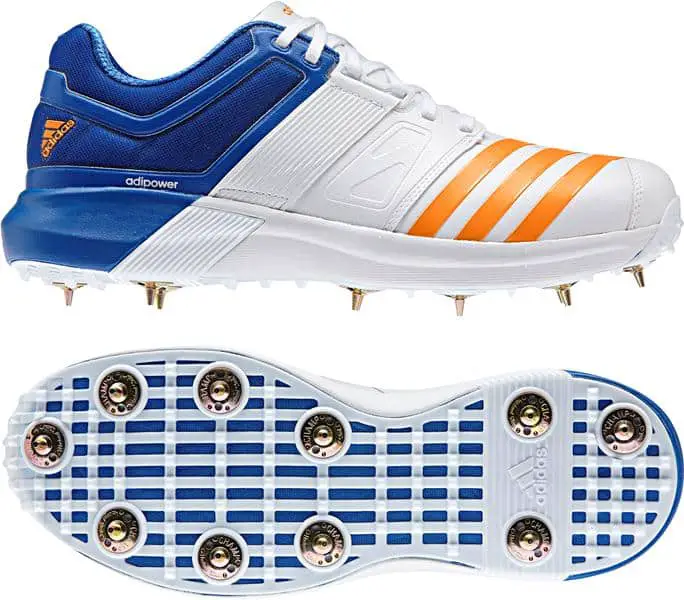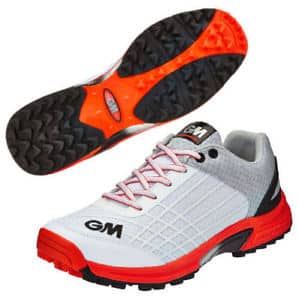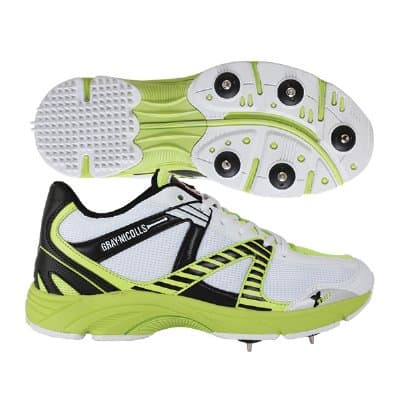If you’re a newcomer to the game of cricket, or even if you’ve been watching for a while and have only just started to think about playing the game, you may be wondering what type of shoes cricketers should wear!
Cricketers wear specialist cricket shoes that look a lot like a normal pair of trainers to the uninformed observer. One of the differences between them however is that cricket shoes are purpose built for cricket, and as such are usually a lot sturdier and provide more support. Cricket shoes will also often have spikes on the bottom surface of the shoe (outsole) to provide the player with grip on certain surfaces. However, it should be noted that not all cricket shoes have these!
You can find out which specific features you will need on a pair of cricket boots by answering a few basic questions about yourself:
- What type of cricket are you playing/what surface it is being played on?
- What sort of player are you (batsman, bowler etc)?
In this post we’ll look at the common answers to those questions and look at cricket shoes based on those answers. We’ll also look at why specialist cricket footwear is important and the typical sorts of brands you should be looking out for. I’ll also try to answer any other questions you may have! Let’s get started…
Footwear Considerations Based On Type of Cricket/Playing Surface
Outdoor Cricket – Natural Grass Cricket Pitch
If you’re playing cricket outdoors on a real natural cricket pitch, then you will usually see players wearing specialist cricket shoes. As mentioned at the beginning of this post, these shoes look like normal trainers except for the fact they have spikes installed on the outsole. The spikes are included in order to assist the player with maintaining their footing while bowling or when playing on pitches that offer little to no grip. I’ve included a picture of a pair of specialist cricket shoes below just so you can all see what I’m talking about!

Outdoor Cricket – Artificial Pitch or Other Surface
Cricket is also commonly played outdoors on other surfaces apart from natural grass. This is especially true at the junior levels of the game! Some of these other surfaces include a variety of different types of turf as well as concrete. If cricket is being played on a surface like this, you will mostly see specialist cricket shoes with rubber dimple designs on the outsoles being worn instead of spikes. An example of this type of shoe can be seen in the photo below. Some types of turf used in artificial pitches permit the use of spiked cricket shoes, whereas some types of turf do not as it could cause the turf to rip. Before wearing spiked cricket shoes on an artificial surface, you should always ask someone whether that type of turf can handle them. Also, and this one may be obvious to most of you…but spiked shoes should never be worn on concrete! You only have to try walking on concrete in a pair of them to see the reason for that!

You can play cricket in normal everyday trainers on these sorts of surfaces, however I would not recommend that in the long term. Trainers designed for everyday wear may lack the support and the grip that is provided by specialist cricket shoes, and using them for an extended period of time could therefore lead to injury.
Indoor Cricket – Artificial/Wooden Surface
A lot of cricket takes place indoors, and this is especially common during winter months when the weather doesn’t allow us to practice outside. For these types of surfaces, I would again recommend choosing a pair of specialist cricket shoes featuring the rubber dimple design on the outsole. This type of cricket shoe should cater to all types of indoor cricket. Spiked cricket boots should obviously not be worn on any wooden surface.
Beware that some indoor venues may require that you possess ‘non-marking’ footwear in order to play. The outsoles of certain shoes can leave scuff marks or coloured lines on some surfaces, which is often not very desirable to the people who own or operate the venue where you’re playing! If you play cricket in a venue which requires non-marking footwear, then you should always ask the seller if the shoes are suitable before you buy.
Footwear Considerations Based On Your Style of Play (Batsman, bowler etc)
Believe it or not, you may want to choose different cricket footwear depending on whether you’re a bowler, or whether you’re a batsman who will either be batting or spending time roaming the outfield.
Bowlers
Bowlers should always wear specialist cricket shoes with spikes on the outsole. The spikes are essential (especially for fast bowlers) in order to maintain grip when landing your front foot on the popping crease. Any slippage of the front foot as it lands could result in nasty injuries, and the spikes help to alleviate this.
However,some bowlers also have very high impact actions that put a lot of additional stress on the feet and ankles. This led to specialist bowling boots being designed. These came with a couple of alterations:
- Specialist bowling boots are usually ‘cut’ a lot higher than regular cricket boots. This means that the material of the boot rises higher up the ankle than a normal cricket shoe would. The height of cut depends on your own personal preference, however the higher cut of the boot the more support that will be given to the ankle joint. This is important as this is one of the joints that is under the most stress during your delivery stride.
- Bowling boots usually have an outsole with a larger surface area than other standard cricket shoes. I don’t want to turn this into a physics lesson but an outsole with a larger surface area allows us to dispel a lot more of the force that results from a high impact action.
- Bowling boots are often constructed from more expensive, higher quality materials that offer better impact absorption. This is especially true when you have a bigger budget and are able to buy a more expensive pair of boots.
The ideal pair of bowling boots will have a high cut to support the ankle and be constructed out of the best materials for impact absorption, whilst maintaining a lightweight feel.

For bowlers the choice of cricketing footwear really boils down to personal preference! All specialist cricket shoes are designed for maximum comfort as well as function, it’s just about deciding whether you would rather have the higher cut ‘bowling boot’ style of shoe instead. I’d recommend trying this style on before buying and rehearsing your bowling action whilst wearing the boots. Only then can you be sure they will be comfortable to wear during play.
Batsmen
Batsmen have a lot more options when it comes to the shoes that they wear while batting. The shoes they wear will often be the specialist cricket shoes with a normal height of cut, meaning that the shoe does not go over the ankle.
The options start to appear when we look at the potential spikes arrangement on the outsole of the shoe. Bowlers should always have a full complement of spikes on their shoes, however, batsmen can choose different arrangements if they wish. Let’s have a look at a few of the different options:
- Full set of spikes – This is the standard arrangement. Incredibly useful on pitches with a bit of moisture in the surface to aid grip when running between the wickets. This arrangement is not ideal for very hard pitches.
- Partial set of spikes – Some cricket shoes come with spikes just on the front part of the foot and none on the heel area. This is the middle ground between a full set of spikes and having none at all.
- No spikes – A batsman may feel more comfortable batting in a pair of cricket shoes with just therubber dimple design on the outsole rather than spikes. This is especially true on incredibly hard pitches. If you’re willing to part with a little bit extra cash, certain cricket shoes offer the option of spikes which can then be removed entirely to leave the rubber dimple design. This type of boots sets you up to play in all conditions as a batsman.

Conclusion
I hope you found all of the information above informative. If you would like to learn more about other types of equipment that cricketers need then I’ve written a post that includes all of that info, and you can see that by clicking here! As I’ve mentioned, the choice of cricket footwear is a very personal one. The type of cricket, the playing conditions, as well as your own comfort must be considered above all other factors! It’s pointless picking a really good looking pair of boots if they don’t allow you to play at a high level! Make sure you try before you buy, and once you have all of the information you can go ahead and make the correct purchase!
Related Questions
Which Brands Are Popular For Cricket Shoes?
Mostly all of the leading cricket sports brands will have their own take on the specialist cricket shoe. Some of the most notable brands that you should be looking out for include Adidas, Gray – Nicolls, Gunn & Moore, Kookaburra, New Balance, Nike, Puma, Reebok & Under Armour.
Prices for junior cricket shoes would usually start at around £20 on the lower end, whereas for men’s cricket shoes the starting price is usually somewhere in the region of £40.
Do Cricketers Wear Different Shoes While Batting and Bowling/Fielding?
The simple answer to this question is that you can choose to wear a different pair of shoes for different periods of the game if you wish, but this depends entirely on the budget you have available. Some cricketers may choose to have two pairs of specialist cricket shoes – one with spikes and one with the rubber dimpled design on the bottom, so that they are prepared for all conditions. Some will choose a pair of shoes which have the functionality of both, where the spikes can be removed to reveal the rubber dimpled design underneath. Finally, some cricketers who are on a more limited budget may just choose to go with a pair of fully spiked cricket shoes.
The choice is entirely yours and hopefully the information I’ve laid out earlier in this post will help you make a sound decision.
Why Do Professionals Sometimes Cut a Hole in the Front of the Shoe?
Sometimes fast bowlers need to cut a hole in the front of the shoe where the big toe is. This is because of the force that goes through the front foot when bowling at high speed. A bowler’s aim is to build momentum during their run up to the crease. This momentum is halted very abruptly when the front foot is slammed down on the pitch. This causes their front foot to move forwards rapidly inside the shoe that they are wearing and leads to their toes getting bunched up at the front of the shoe. This can lead to nasty feet/toe injuries. Some bowlers have a real problem with this and find relief by cutting a hole near the big toe. This time, when they run in to bowl and slam their front foot down, the foot moves forward and the big toe is allowed to ‘escape’ out of the front of the boot.
Can Spikes Be Added to Other Normal Trainers?
The answer to this is yes, some bootmakers may be able to add spikes to turn a relatively normal pair of trainers into spiked trainers. However, I wouldn’t advise you to do this. Purchasing a pair of specialist cricket shoes is always the better option in my opinion. A lot of research goes into the manufacture of cricket shoes and the end result is footwear that helps protect our body against the stresses that are caused by cricketing movements such as bowling etc. I read some research online recently that said that the stresses in the lower limbs was measured to be much lower when bowlers were wearing specialist cricket shoes.
Can Spikes Be Replaced?
Of course! You will be able to pick up replacement sets of spikes for your cricket shoes from most sports retailers if yours get damaged or lost.
